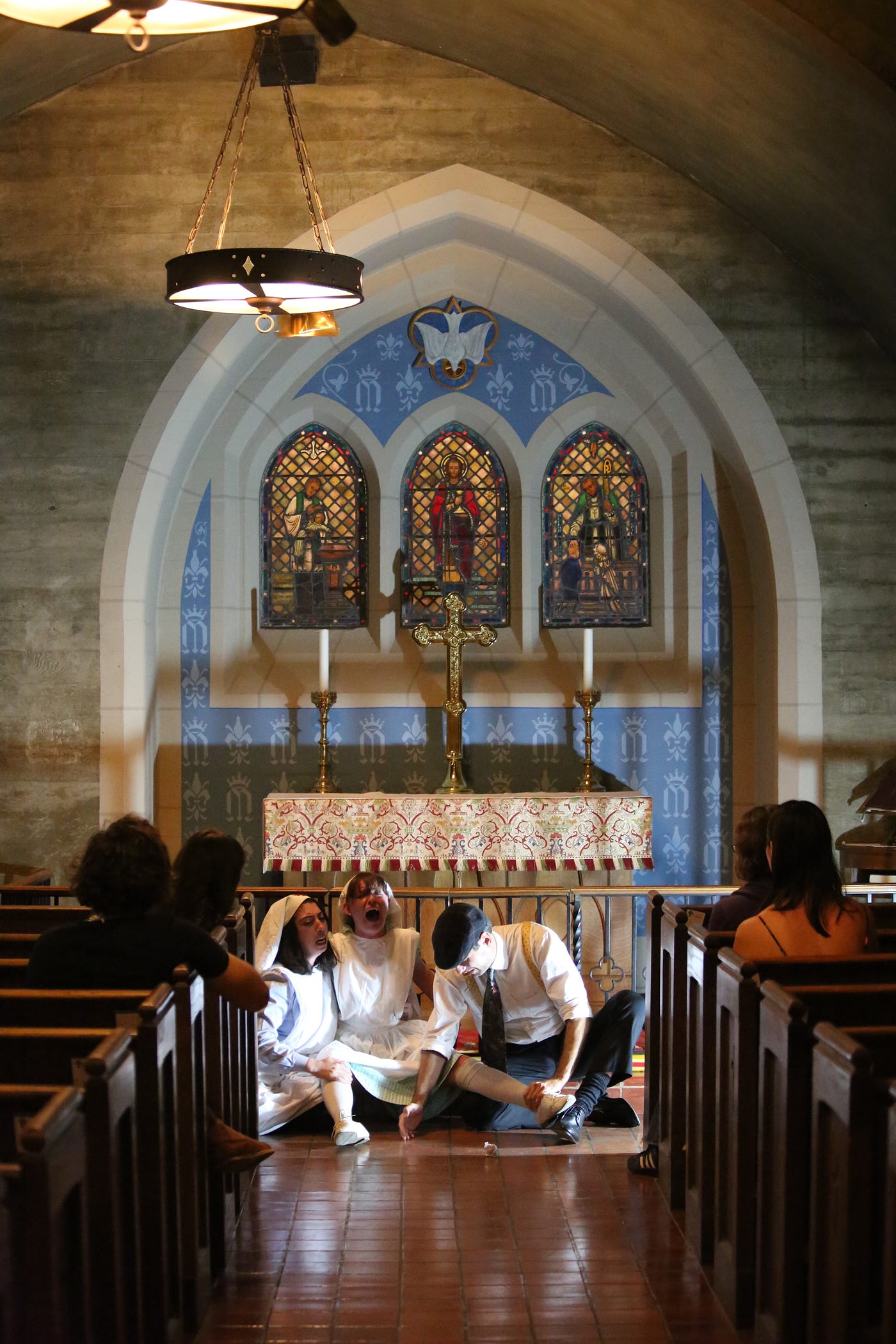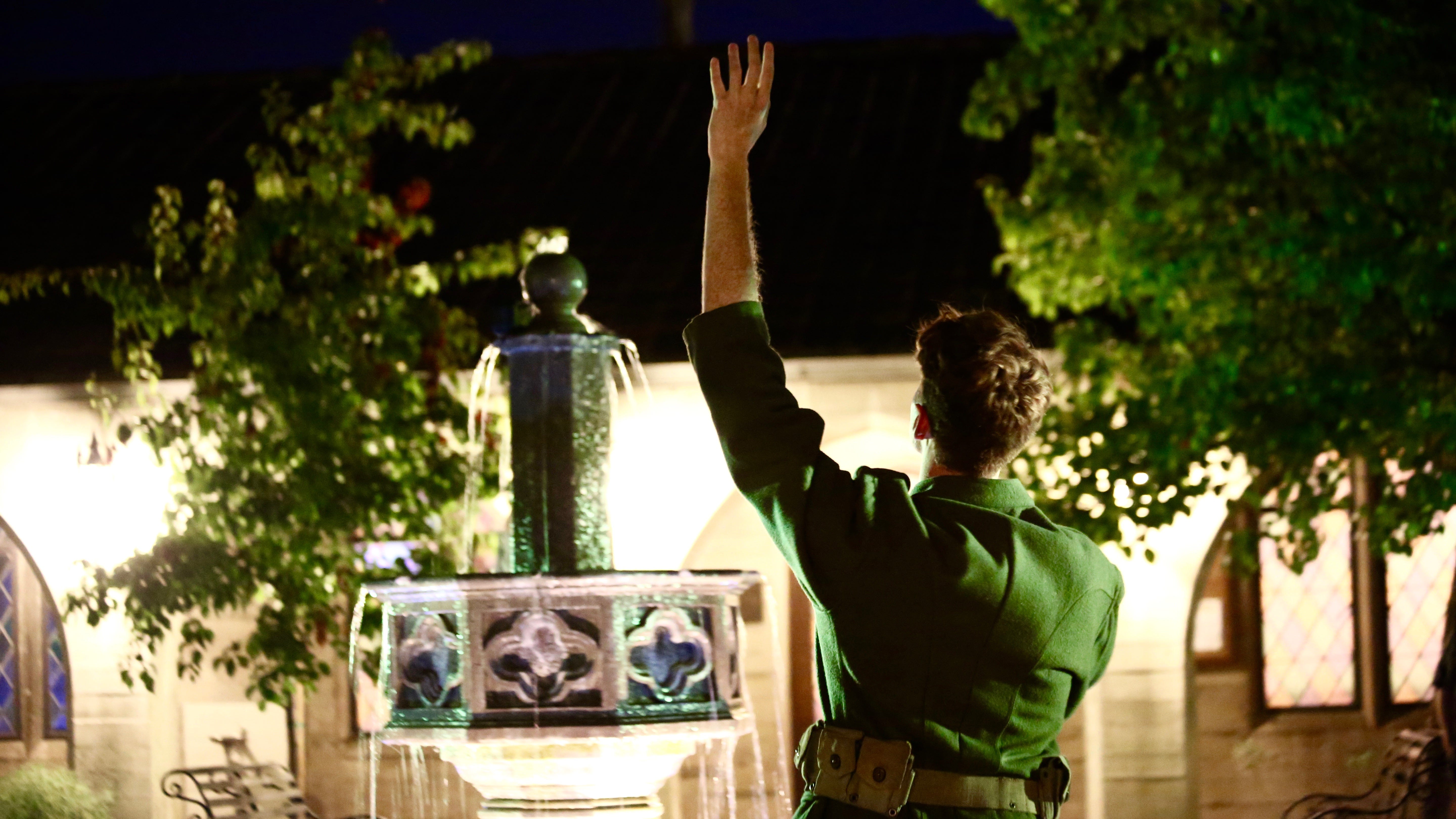
Before we start I need to preface this with a note on my condition when I saw the show. I had woken up at 3:45A Eastern to get on a plane to fly back to LA after getting stuck for 24 hours thanks to the first canceled flight I’d ever faced. With showtime at 8:00P Pacific, that means I’d been up for more than 19 hours, much of it in transit. So, you know, I wasn’t my usual peppy self. This kind of thing matters with any piece of work, but with immersive it is doubly important.
We’ve been following the work of LA’s Speakeasy Society for some time now. Starting with the “theatre for one” piece The Stronger all the way through their holiday specials Ebenezer and The Hollow. They are, without question, LA’s most prolific, consistently good, creators of immersive theatre.
(And I will, for the record, point out that I count the artistic directors as friends. But if you think that will stop me from giving an honest assessment of the work you have no idea who you are dealing with.)
Their latest production, Johnny: The Shell, is the second part of a three-part adaptation of Dalton Trumbo’s Johnny Got His Gun. I caught the first part last year having not read Trumbo’s work, and in the interim I’ve yet to read the piece. Perhaps I should have. While the aim of this piece was to create a work of theatre which didn’t require prior knowledge of the text I can’t help but get the nagging feeling that a greater familiarity with the work would have helped.
Johnny: The Shell represents a step forward for the Speakeasy Society. It’s an ambitious experiment which aims to take a good sized audience — 30 or so — through a “dark ride” like construct. Audience members are sorted into groups and sent along pathways that unfold part of the narrative line. There are solo experiences, group performances, and scenes played for small chunks of 2–6 people.
Some of it works exceptionally well, and some of it stands on less than sure footing. Nor is it one type of performance technique that works better than others.

Upon entering St. Marks Episcopal Church in Glendale — which is surprisingly stunning — I was greeted by a series of characters in short vignettes. And I do mean short. A minute here, 30 seconds there, and then I was ushered to a pew — I was the last in line, on purpose — by a nurse (Christie Harms) who grounded me into the space with solid eye contact and a real sense of presence.
By this point I wasn’t entirely sure what was going to come next — the previous part of the planned Johnny Cycle was a lot more linear and had a clearer narrative starting point — but I was ready to be there thanks to Ms. Harms.
The first group scene contained the first stumble of the night. The premise was that of a General addressing the troops — all of us having been endowed as the titular Johnny thanks to the tag which functioned as our ticket — as we are set to fall out on our various missions (tracks). From a conceptual standpoint, this is perfectly solid, but the sound design and acoustics of the space seem to be at odds. Perhaps the intention is for the General to be somewhat unintelligible. I thought it might have been my hearing — I was exhausted, after all — but after comparing notes with another attendee of a different performance I’ve settled on this being a flaw. One that could be leaned into, but that instead started to raise a barrier to my experience.
Get Noah J Nelson’s stories in your inbox
Join Medium for free to get updates from this writer.
SubscribeSubscribe
Next came what for me was the most awkward, kind of unnecessary, scene of the night. A one on one with a figure I’m calling “the lonely doughboy.” In short: dude wants to lose his virginity before shipping out. As I experienced it the scene was staged in an awkward, uncomfortable manner. All I could think about was what if I was a woman being placed in the situation this placed me in. As it turns out our colleague Juliet Bennet Rylah had the same one-on-one and she could tell you exactly what that was like.
What’s strange to me about our two experiences is that while I was nebulously a guy in the scene she was clearly a woman. Yet we are all endowed with the persona of Johnny at the start of the show. We are gendered male, collectively. Is this an intent of the script that isn’t being followed by the actor? Or is that improv part of the design? This is a scene that, for me, needs a lot of work — because it served to throw me out of the world of the piece. An attempted seduction — even a pathetic, botched one — is something that can work in immersive, but this just isn’t that.
So I was relieved when I was pulled off to the next scene.
As the night moved on the work got, for me, stronger and stronger. A two-hander between doomed lovers was one of the most moving moments I’ve had in an immersive, while the bonus scene that those who have been to previous Speakeasy shows can unlock with a token is an absolutely stellar piece of work that shows just how robust and daring the Speakeasy Society can be. (Special shout out to Matthew Bamberg-Johnson’s for his work there.)
Unlike the previous part of the cycle, I found myself rather disconnected from the character of Johnny. While Part I played with the idea that sometimes we were Johnny, sometimes an anonymous observer, here the distance feels more set. I found myself wishing that the choice had been made to go more clearly the other way. On the track that I was on the nature of Johnny’s injuries were not really explored, although I know from other reports that there is material in the piece which confronts that head on.
One thing which carried over from the first Johnny, which is a brilliant innovation, are the moments where characters instruct audience members to say certain lines. This kind of directed agency skirts the line between interactive and passive theatre — it isn’t total agency, but a kind of “handing the baton” to the audience. We complete the circuit. It’s a technique I hope the company explores for years to come: a true addition to the immersive toolbox.
An addition to the Speakeasy Society palette is the amount of movement-based work that drives this piece. It is the focus of most of the large group scenes, including a significant chunk in the middle before the various groups are sent on new pathways.
In this, the troupe follows in some of the footsteps — intentionally or no — of Third Rail Project’s The Grand Paradise. The results are somewhat the same: a touch of disconnect as we wait for the pieces to snap back together and let us into the more intimate configurations. Right now this seems like the biggest hurdle in doing work for mid-sized audiences, and no one seems to have cracked the nut. The fountain sequence goes on a bit longer than you might want, and while it manages to make some lovely tableaux, the movement phrases that are introduced never quite transform into something that seems significant.
For example there’s a particular movement phrase that is a reference to attempts to communicate with the deaf, blind, mute, and limbless Johnny. It is introduced to each audience member beautifully but doesn’t appear to go anywhere beyond that. For a moment it feels like we’re being taught a new way to communicate with each other, but then that moment passes. The feeling that something magical is just on the other side of this idea has stayed with me for days now. In short: an enticing set-up that doesn’t seem to have a payoff.
The second half of the show moved briskly, and in the order that I received the pieces seemed to delve deeper into the philosophical critique of war that is the heart of the original text. It did so in an embodied way that was satisfying: touching on a spiritual dimension without ever hitting it squarely on the nose. There’s no doubt in my mind that the company is honing what will be, and in many cases already is, the finest troupe of immersive actors on the West Coast.
This is bold work from the Speakeasy Society, and while Johnny: The Shell shows me that there is still work to be done it also reaffirms my faith that the company has both the capacity and the will to take on the challenges of crafting immersive. If anything I wanted the piece to be longer, as I only felt it was hitting its stride as the night went on.
Oh, well, guess I’ll have to ship back out for another tour.
The Johnny Cycle: Part II — The Shell runs now through Aug. 31 at St. Mark’s Episcopal Church, 1020 N. Brand Blvd. in Glendale.




















Discussion